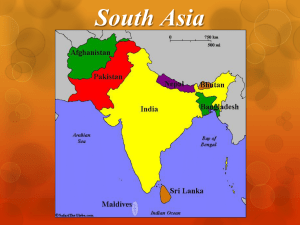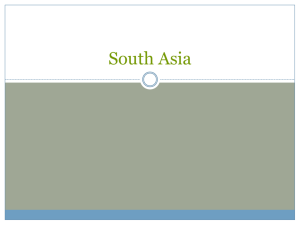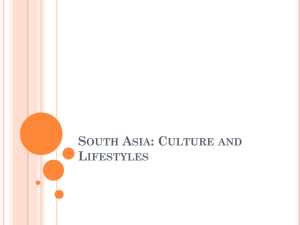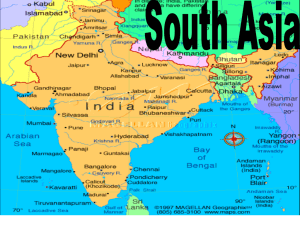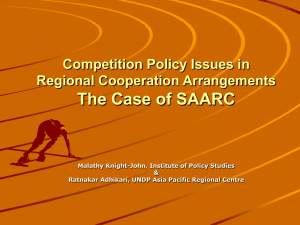1. South Asia is sometimes called a
advertisement
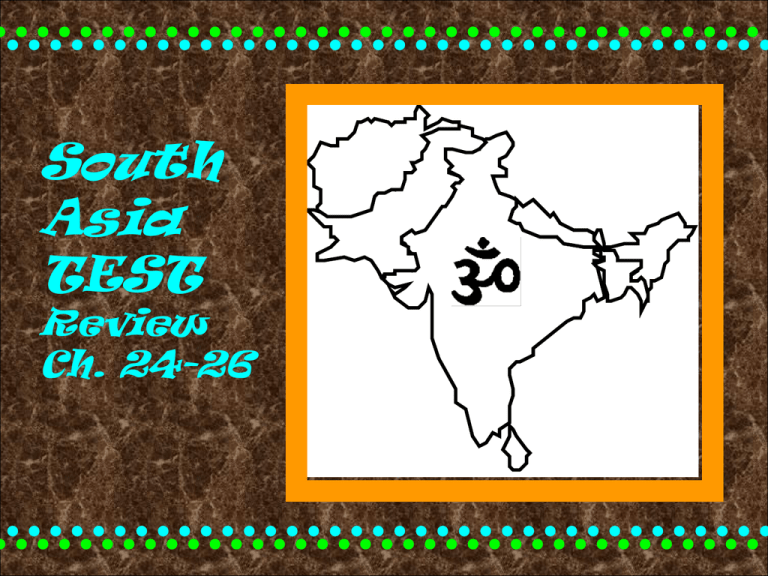
South Asia TEST Review Ch. 24-26 1. South Asia is sometimes called a ________________ - a major landmass smaller than a continent. 1. subcontinent 2. An___________ is an island that is a low-lying top of a submerged volcano. 2. atoll 3. Mt. Everest is a towering peak in the________________. 3. Himalayas 4. When rivers flood, they deposit soil on ___________ plains. The Indo-_________ Plain is one of these and it is able to support a heavy population. 4. alluvial/ Gangetic 5. Timber resources in India, Bangladesh, and Sri Lanka are being threatened by__________________, or the cutting down of trees. 5. deforestation 6. _____________ are seasonal winds that can bring either dry or moist air to South Asia. 6. monsoons 7. The type of storm that caused severe devastation in Bangladesh in 1970 was a _______________. 7. cyclone 8. Thousands of Hindu pilgrims gather at daybreak along the banks of the _____________, the river they believe brings life to the Hindu people. It is known as ____________ in India. 8. Ganges River/ Ganga or Gangamai 9. Cyclones often cause _______________ --huge water that swamps low-lying areas. 9. storm surge 10. If you were driving across the dam on the Feni River, you would be viewing a body of water known as an_____________--an arm of the sea at the lower part of a river. 10. estuary 11. An ________________ is a group of islands that sometimes form an arc. 11. archipelago 12. Because they bring much needed rains to the region, ____________ are crucial to life in South Asia. 12. monsoons 13. The most extreme weather pattern in South Asia is the_____________, a violent storm with fierce winds and heavy rains. 13. cyclone 14. ______________ is the religion of most people who live in India. 14. Hinduism 15. Mohandas Gandhi’s opposition movement against British rule was based on___________________. 15. nonviolent resistance 16. Muslim rulers, such as those who governed the Maldives, are called_____________. 16. sultans 17. The Muslim month-long period of fasting and prayer is called________________. 17. Ramadan 18. There were four basic categories in the original Hindu___________ system. Below these four are the Dalits, sometimes called the__________________, because of the work they do. 18. Caste/ untouchables 19. ____________ are the traditional mountain guides in Nepal. 19. Sherpas 20. While meditating, a Tibetan Buddhist might use a _______________, a geometric design. 20. mandala 21. By the early 1500s, Muslims had conquered areas of India and established the____________Empire. The structure called the________________ is an architectural masterpiece built during this period. 21. Mughal/ Taj Mahal 22. India and Pakistan have fought bitter wars over the territory called ___________, in northern India. 22. Kashmir 23. The__________was the 90-year period of direct British rule over India. 23. raj 24. About 75 percent of the population of Sri Lanka is made up of the Buddhist group known as the _____________. The minority are made up of a group called the__________, who are Hindus. 24. Sinhalese/ Tamils 25. A ruler’s powers are limited by a constitution in a system of government called a: __________________. 25. constitutional monarchy 26. The division of India in 1947 into two countries, India and East & West Pakistan, is known as the ______________. Its purpose was to divide Hindus and _____________. 26. partition/ Muslims 27. Sri Lanka is one of the world’s leading ___________-producing countries. 27. tea 28. __________________ was the founder of Buddhism. He was born in present-day Nepal. 28. Siddhartha Gautama 29. A person who starts and builds businesses is an_______________. 29. entrepreneur 30. _____________________ was the highly developed urban civilization that existed in 2500 B.C. in present-day Pakistan. 30. Indus Valley civilization. 31. ______________ is the policy of trying to balance distribution of land among farmers in South Asia. 31. land reform 32. The__________________ Mountains are located at the western end of the Himalayas. 32. Hindu Kush 33. The tear-shaped island of _____________ is located in the Indian Ocean just off India’s southeastern tip. 33. Sri Lanka 34. The Eastern and Western_________ are located on either side of the Deccan Plateau. 34. Ghats 35. The _____ Desert is located in northwestern India. 35. Thar 36. The three great river systems of South Asia are the______________, ______________ and ________________. 36. Ganges, Indus & Brahmaputra 37. K2 is located in the________________ Mountains that are located in the north central portion of the Himalayas. 37. Karakoram 38. The South Asian peninsula extends south into the ________ Ocean and is bordered by the _______________ to the west and the_______________ to the east. 38. Indian Ocean/ Arabian Sea/ Bay of Bengal 39. Most energy in South Asia is still generated from_____________ resources. 39. mineral 40. The____________ climate zone of South Asia has the coldest climate. 40. highland 41. ______________ plants have been built along the Ganges River to clean-up the water. 41. sewage treatment 42. The Ganges source is in a Himalayan______________ and it empties into the ___________________. 42. glacier/ Bay of Bengal 43. The most important river of Bangladesh is the__________________. 43. Brahmaputra 44. The_______________ crossed the Hindu Kush Mountains and spread across northern Indian, pushing the natives, called______________, to the south. 44. Aryans / Dravidians 45. _____________ and ___________ remain at the center of Indian life. 45. marriage/ family 46. Under Prime Minister_____________, India adopted a _____________, making the new country a democratic republic. 46. J. Nehru/ constitution 47. Beginning in 321 B.C., the ______________ Empire united most of India. Several centuries later, the_______________ Empire came to power. In the 1500s, the Mughal Empire took control, 47. Mauryan/ Gupta 48. In Hinduism, ___________ is the term for the moral consequences for one’s actions, either in this life, or the next. The goal of the devout Hindu is ________________, breaking the endless cycle of birth, death & rebirth called___________________. These ideas came from the last of the Vedas . These are known as the__________________. 48. karma/ liberation/ reincarnation/ Upanishads 49. In 1971, __________ Pakistan won its independence as Bangladesh. 49. East 50. The most productive farming areas of Pakistan are the irrigated portions of the __________ Valley. 50. Indus 51. ___________ is a special interest in both Pakistan and Bangladesh. Poetry readings, called______________--can draw thousands of people, much like a concert. 51. poetry/ mushairas 52. A mountainous landscape is the main geographic feature of _________ and __________, the most remote countries of South Asia. 52. Nepal/ Bhutan 53. The three main gods of Hinduism are _____________, ____________, and ______________. They are three aspects of Brahman. The son of Shiva and Pavarti is ______________, the god with an elephant head. Krishna, another popular god, is an incarnation of Vishnu 53. Brahma/ Vishnu/ Shiva/ Ganesh 54. One of the fastest growing industries in Nepal is_______________. 54. tourism 55. Hindu kings once ruled Nepal, while ______________ priests controlled Bhutan. 55. Buddhist 56. China controlled ___________ briefly in the 1700s, explaining why Buddhism is a dominant religion there. 56. Bhutan 57. Farmers in Nepal and Bhutan create _____________ on the mountainside to increase the amount of farmland and limit soil loss. 57. terraces 58. ______________ and ____________ from Sri Lanka and India settled the Maldives. 58. Hindus & Buddhists 59. In 1972, Ceylon adopted a new constitution and renamed itself the__________________. 59. The Republic of Sri Lanka 60. Food, clothing and shelter are known as the_________________. Many people in India lack these things. 60. basic necessities 61. __________________ is the inability to read and write. 61. illiteracy 62. A___________ monsoon has winds that blow from the northeast across the Himalayas toward the sea. 62. winter 63. A_________ monsoon has winds that blow from the southwest across the Indian Ocean toward South Asia. 63. summer 64. For many Indians, children represent________________ in old age. This explains why families are so large in India. 64. security 65. Unless the growth rate slows down, India will be the most_____________ country in the world, surpassing China. 65. populated 66. The rains that accompany the summer monsoons are critical to _______________ in South Asia. 66. farming 67. In 1998, India and Pakistan each tested__________________. 67. nuclear weapons 68. Kashmir was mainly__________, and Pakistan and India have fought three civil wars over control of the region. 68. Muslim 69. In 1947, the______________ government formally ended its colonial rule over the Indian subcontinent. 69. British 70. Kashmir is a territory at the foot of the_________________. 70. Himalayas
